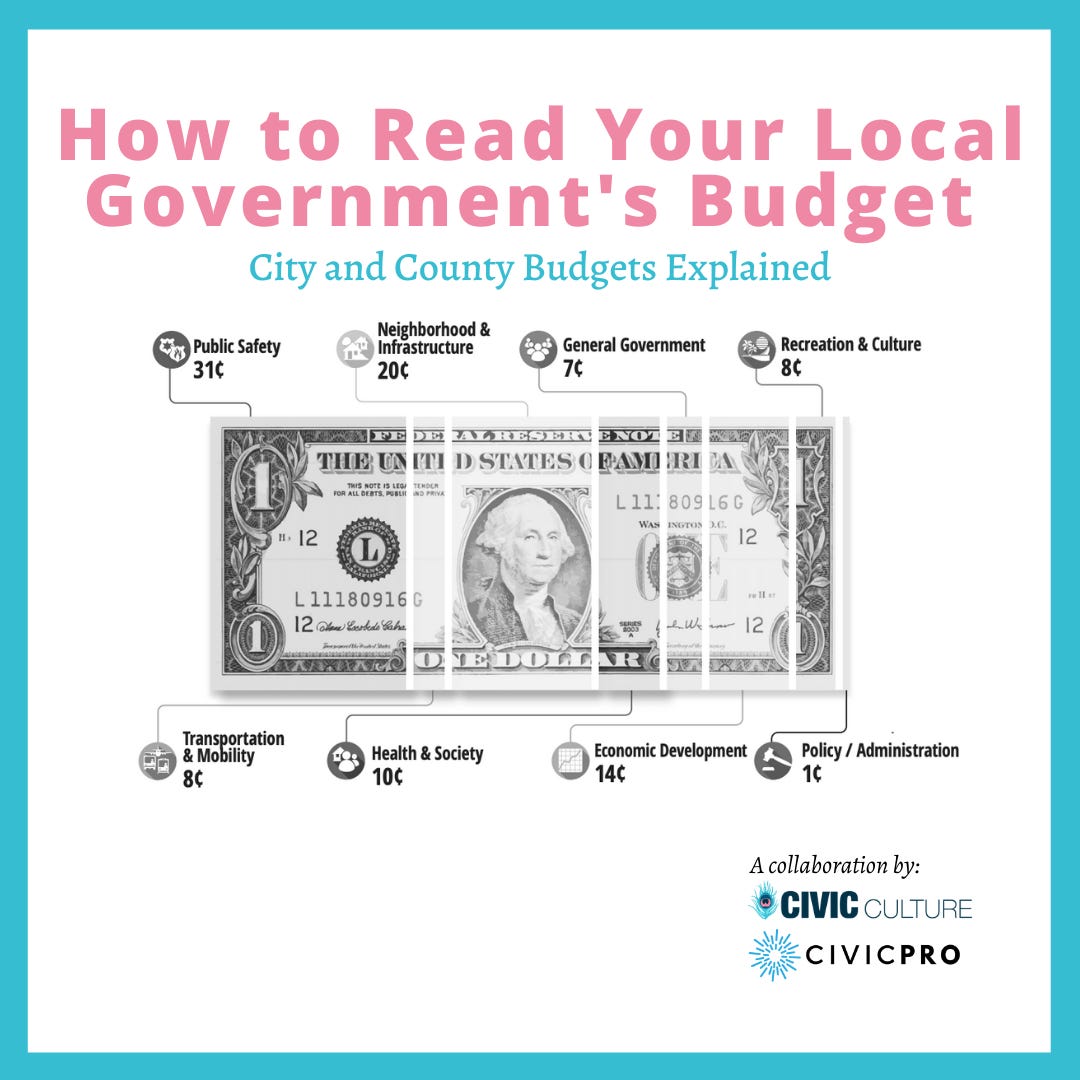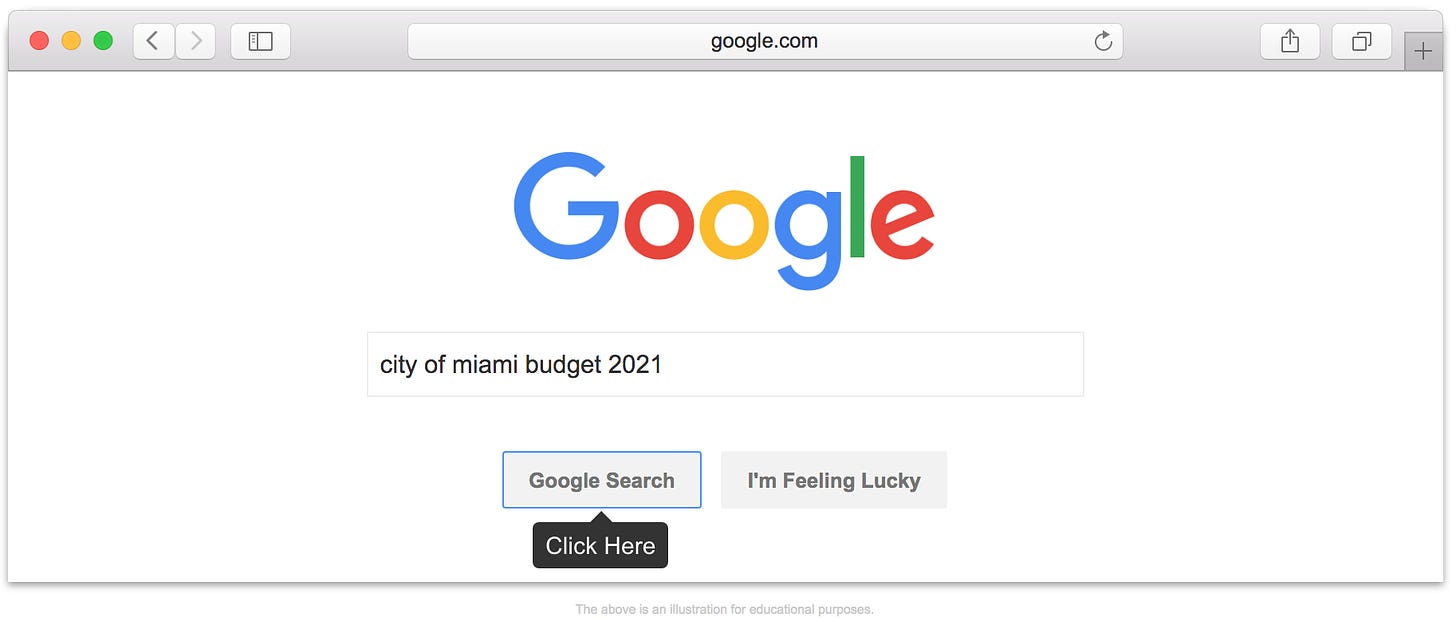
This explainer is a collaboration with my friends at CivicPro, a platform that makes it easier to track and engage with local policy decisions. CivicPro lets users track issues like the environment, housing, and education across multiple local governments. Anyone can sign up for free at open.getcivicpro.com. For this municipal budget season in South Florida, we teamed up to bring you this guide to understanding the common terms in local budgets.
How do I find information on my city or county budget?
Local government budgets are dense. Not only that, but with almost 90,000 local governments in the United States, there is a lot of variety in the way they handle those budgets.
The quickest way to find your local budget is probably with a Google search that includes the name of your city or county, the word “budget,” and the upcoming year:

Once you’ve found the budget page for your local government, try finding documents that summarize the proposed budget for the upcoming fiscal year.
Two specific documents worth focusing on are:
The Budget in Brief (or something with a similar name)
The Mayor’s Message (or something with a similar name)
Click here to view the FY 2021 Budgets in Brief for the City of Miami and Miami-Dade County.
Want to learn more about what it takes to approve a local budget? Check out these explainers:
I found my local budget info. How do I decode it?
Table of Organization: Most municipal budgets include an organizational chart or table that breaks down the structure of the local government. An org chart is a great place to start decoding a municipal budget and understanding the role of individual departments in providing government services.
Budget Summary: Many municipal budgets, especially in large cities with complex, multi-volume budget documents, will come with a shorter summary of the budget’s key points. This document is a good place to get a bird’s eye view of the entire budget.
Budget Types: It’s important to remember that governments and private companies operate differently. Those differences affect how things work all the way down to accounting practices and how public money can be used. Every year, local governments split their budgets into two main parts called a “Capital Budget” and an “Operating Budget.”
Capital Budget: Major improvements to facilities and infrastructure are funded by this budget. Those projects could include roads, sewer systems, new building construction, water supply networks, or even electric power plants. In Chattanooga, Tennessee, the Capital Budget also includes a line item for high-speed, publicly-owned internet service. Local governments base these investments on a multi-year Capital Improvements Program or Plan (CIP) and support their projects through multiple funding sources, including different types of bonds (debt), grants, cash, and other smaller sources of funding.
Operating Budget: The day-to-day costs of running a city or county, including salaries, are covered by this budget. It is funded primarily through local property and sales taxes but license fees, franchise fees for a company’s use of local rights-of-way, charges for services, fines and other smaller sources of revenue (like interest on investments) contribute to this pool of public money.
Fund Types: Local governments’ Operating Budgets are often further separated into specific groups, like the following fund types:
General Fund: A government’s primary operating fund. It includes revenues from a variety of sources, including fees, fines, and state and local taxes like property taxes. Personnel costs, including wages and employee benefits, are typically the largest expenditure.
Special Revenue Fund: Revenues in this fund are restricted to a specific purpose.
Internal Service Fund: The purpose of these funds is to centralize all costs in a single fund to obtain economies of scale, develop rates to charge all departments, and bear the cost of any unanticipated expenditures throughout a year. For example, a fleet fund purchases and maintains a local government’s fleet of vehicles. Likewise, many government departments provide services to other departments within the same government. Internal Service Funds also cover those goods or services bought and sold within a single government - typically on a cost-reimbursement basis.
Debt Service Fund: Money in this fund is used to repay any debt (like debt from bonds) incurred by the government, including interest.
Revenue Sources: Local governments rely on a variety of revenue sources to fund the services they provide to residents. Taxes usually provide the largest share of government funding but most municipalities also rely on many other types of revenues to fund operations and infrastructure projects. Not all revenues are alike: some funds, such as state and federal grants, are “restricted” funds, meaning that they can only be spent for limited purposes.
Property Taxes: Property taxes, sometimes called ad valorem taxes, are taxes paid by owners of real estate. In the City of Miami, property taxes make up a 52.2% share of the annual budget while in Miami-Dade County that share is slightly lower at 35% of the budget. The amount of taxes a property owner pays depends on that property’s value and the tax rates charged by the local government and other taxing authorities. Property tax rates can be broken into two general categories:
Millage rate: A millage rate is the tax rate paid by property owners that generates money for a government’s general fund. A millage rate refers to the dollar amount assessed on every $1,000 of property value. A rate of 4.67 mils (Miami-Dade County’s 2019 rate) means that $4.67 of tax is imposed for every $1,000 of a property’s value. Under that scenario, a property with a value of $200,000 would be subject to $934 in property taxes.
Debt millage rate: A debt millage rate is the tax rate paid by property owners that generates money to pay off a government’s debt (usually from issuing bonds). Just like the general millage rate, the debt millage is a dollar amount assessed on every $1,000 of property value. A debt millage rate of 0.48 mils (Miami-Dade County’s 2019 rate) means that 48 cents is imposed for every $1,000 of a property’s value. A property worth $200,000 would be subject to $96 in property taxes devoted to debt service.
Other Taxes: Aside from property taxes, local governments may collect other types of taxes, such as:
Sales taxes,
Gas taxes, or
Business taxes.
Proprietary Fees: In addition to property taxes, many local governments rely on revenues from proprietary fees charged to customers. These fees are designed to cover or partially cover the costs of certain services they provide.
Some examples of Proprietary Fees include:
Permitting Fees: Local governments usually charge fees to obtain building, special events, and other types of permits. Permitting fees compensate the local government for the personnel, inspection, and other administrative costs of reviewing permit applications.
Leases: Local governments are often major landowners in their communities. Parks, government offices, airports, sea ports, community centers, and other services all require land. When local governments lease publicly-owned land to private organizations or businesses, any rent those entities pay go back into the public coffers to fund other services.
User Fees: User fees are a large category of fees that governments charge for use of public facilities or infrastructure. Examples of user fees include transit fares, trash pickup fees, docking charges at airports/ sea ports, water and sewer fees, utility fees, and fees for health care services at public hospitals.
In addition, governments that operate large enterprises, like airports or sea ports, may generate revenues from activities that fall under the Proprietary Fee category. In some budget documents, these are also referred to as “Enterprise Funds.”
Fines: Most local governments enforce their ordinances and policies through monetary fines. Common fines include library fines, parking tickets, and citations for building fire/safety violations.
Federal and State Grants: Grants from federal and state governments to local governments provide funding earmarked for a specific purpose, such as purchasing equipment for law enforcement, building or repairing roads, and cleaning up pollution.
Got any questions about local government budgets that this explainer didn’t answer? Leave a comment on the web version of this newsletter, reply directly to this email, or send me a message at leah@civicculture.co.


